New Boston Historical Society
New Boston, New Hampshire
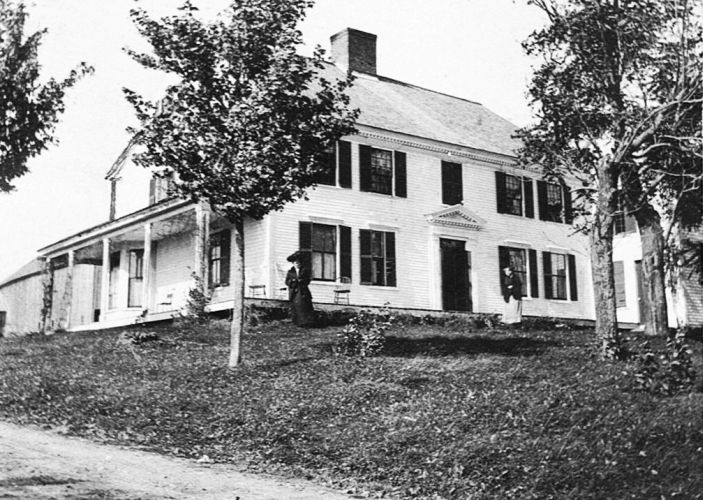
Summit Farm House in New Boston c.1890
The House That Went to Cape Cod
The Historical Society has written about New Boston's Summer Boarding Houses, homes which were opened to visitors every summer in the 1890s and early 1900s. The notes in our files about the Summit Farm House declared that this particular house was moved 140 miles to Cape Cod, which seemed improbable to us. It wasn't until 2022 that we learned the whole story, after we spoke with Walter Kirsch, the grandson of the Kirsch brothers who operated the Summit Farm House for ten or twenty years.
Let's begin at the beginning... Our research indicates that the two-story center-hall Colonial you see at the top of this page was built in 1773 by William Stinson as a wedding present for his oldest son, David Caldwell Stinson, and David's new wife, Mary Stark.
Mary Stark Stinson was the niece of General John Stark of "Live Free or Die" fame. Her father-in-law William Stinson was one of the original settlers of Dunbarton and was reputedly the wealthiest man in the county. William was a thrifty man; when he brought rum to his field workers he used a bottle with an extra-narrow neck so that no man drank too extravagantly. However he did build a nice house for each of his sons.

This 1771 deed records the sale of 300 acres by William White of Bedford
to William Stinson of Dunbarton for the sum of one hundred & thirty eight pounds.
I traced the 250-year ownership of this property through 17 deeds filed at the Registry of Deeds in Nashua. I found one extraordinary record from 1818 in which the Jacob Dodge estate petitioned to divide his property among all his numerous heirs. The cider house went with one parcel and the hog pen with another, and the house itself was divided too! "All that part of the Dwelling House south of the Chimney from the top to the bottom with south fireplaces in the Chimney, all the cellar under the same... privilege to the Oven in the kitchen in Common," and so forth. Dodge's son-in-law Daniel Andrews promptly bought everyone else's shares so that he and his wife Hannah could enjoy the house in peace and quiet.
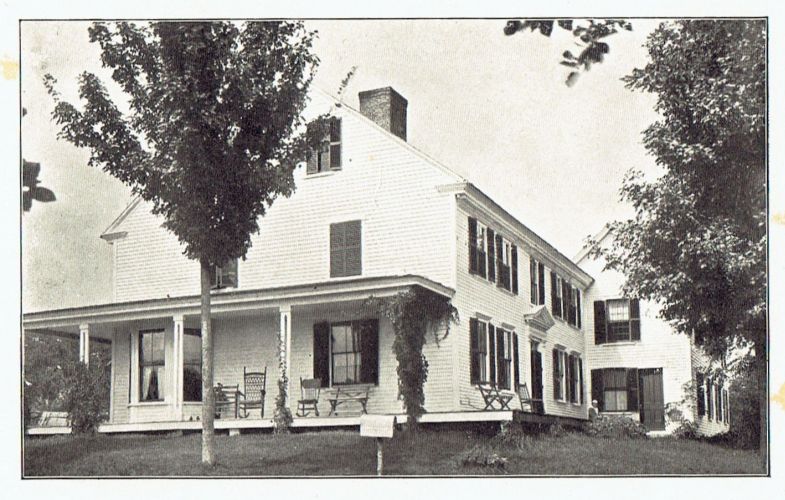
S. L. Marden's brochure shows the farm house and the attached "ell."
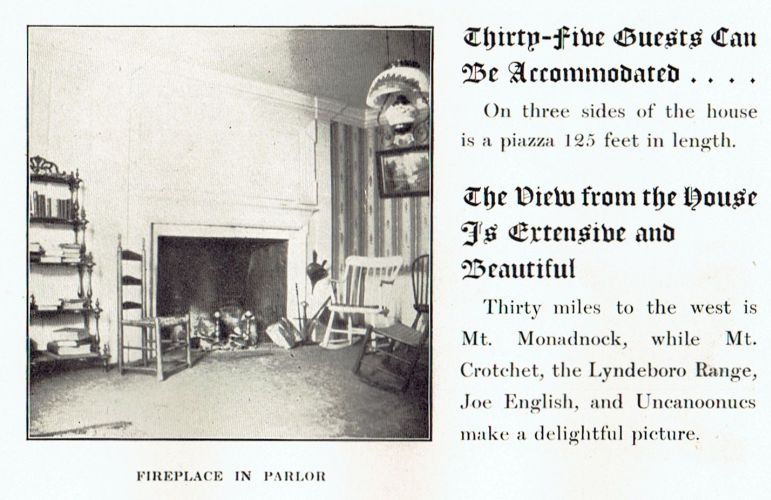
This interior photo provides our only view of the 18th-century woodwork that was custom-made in England.
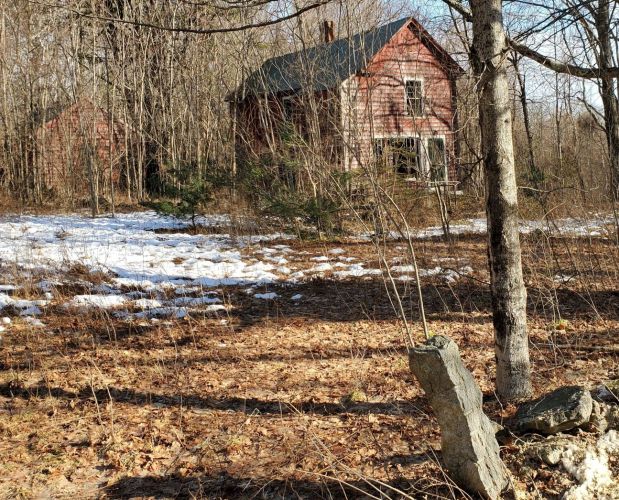
The six-room "ell" is all that remains in New Boston of the Summit Farm House.
It was Fred's grandson Walter Kirsch who provided us the clue that enabled us to locate the Stinson house in Massachusetts, with the help of three other historical societies. Walter visited the New Boston Historical Society in October of 2021 to be interviewed about growing up in New Boston in the 1930s and 40s. He remembered that the house his grandparents owned went to Woods Hole — that was new information to us!
A few months later, while I was supposed to be editing the 25-page transcript of the Kirsch interview, I decided instead to Google "new boston" "woods hole" "house" "moved" — with no expectation I'd find anything interesting. To my surprise the very first result was a catalog entry for a photo album of New England houses that were relocated "probably in the 1940s," including one from New Boston! Could this be the Stinson house?
The physical album is in the collection of Historic New England in Boston, so I contacted their Archive Specialist, who sent me an image of the relevant page from the photo album. There were interior and exterior photos of the "Old Goodhue House" in New Boston, and these seemed to match photos we have of the Summit Farm House. (We studied these photos with a magnifying glass, as there must be thousands of Colonial-style houses in New England with two windows on either side of a central door. Fortunately there were photos from different angles that captured unique identifying features like the stovepipe of the Summit Farm's summer kitchen.)
We still didn't know exactly where the house was moved, so I asked the archivist to look at the album again. A week later she sent me another page with photos of the house in its new location, labeled "Moved from New Boston, N.H. to Falmouth / Woods Hole for Mrs. Theodore Brown." Unfortunately the album did not provide a street address. I tried Google satellite and street views, looking for a center-chimney Colonial somewhere in Woods Hole or Falmouth, but I was unsuccessful.

Colleen also sent us pages of information about the house compiled by Stark Whiteley, whose parents had purchased the house from the Browns. It was Whiteley's history and multiple articles from the "Falmouth Enterprise" dated 1935-1949 that informed us when the house was built and by whom.
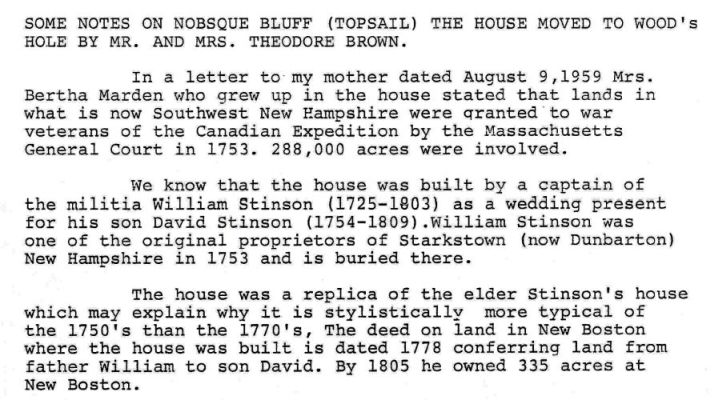
Stark Whitely documented the house's history.
A man named George Holden Greene and his wife Marion specialized in house moving. Stark Whitely wrote: "Greene moved the house timber by timber, brick by brick from New Boston to Wood's Hole (by train???) The original hand hewn timbers, the wide floor boards, the paneling, the chimney and its bricks, the old window glass, the hinges and the old nails all were re-used."
The Falmouth Enterprise reported in 1936: "Externally, at least, the Brown house, with the exception of its new shingles and new paint, has not been altered in re-erection. Since plaster walls cannot be taken down intact, the interior must of necessity have new features. All of the original paneling, doors and casings, and fire places have been retained. Virtually all the timbers of the original have been retained. There is some new joisting. All the planking is old. The attic, with its dusty board floor, its massive roof timbers, and its gigantic chimney, might still be back in New Hampshire. All the timbers are pegged. Four large uprights support the peak. The chimney as it rises from the second floor is about seven feet one way, five feet the other."

The Stinson house — now in Woods Hole, Massachusetts
-- Dan R. 2022
